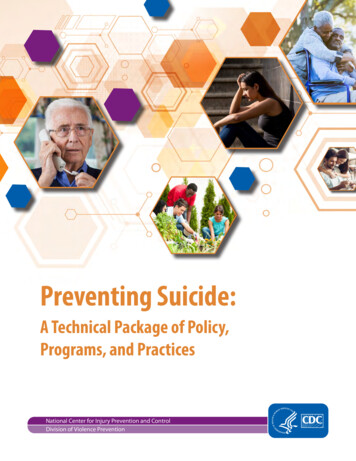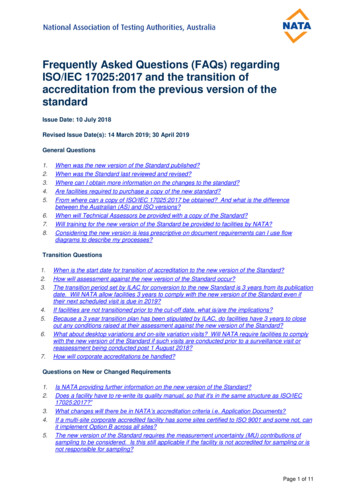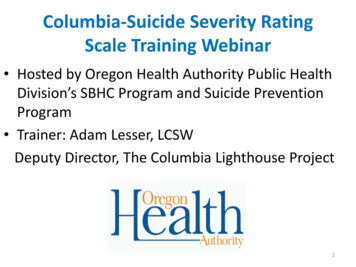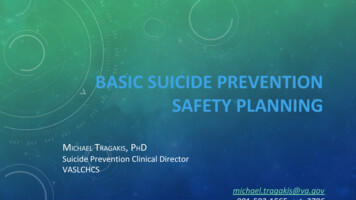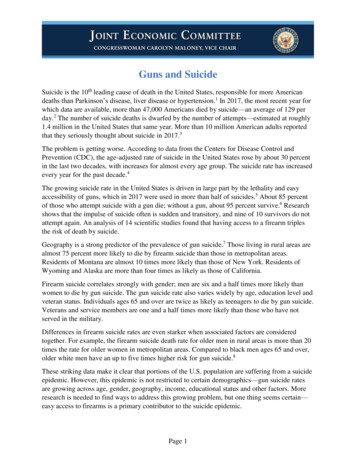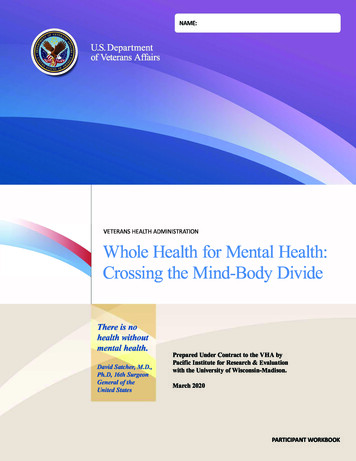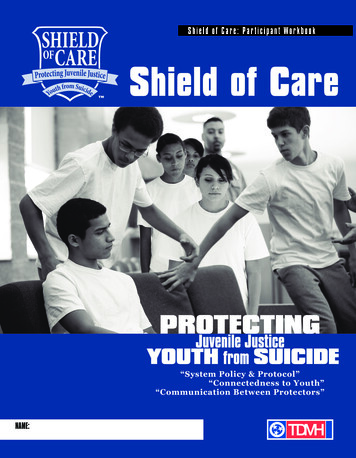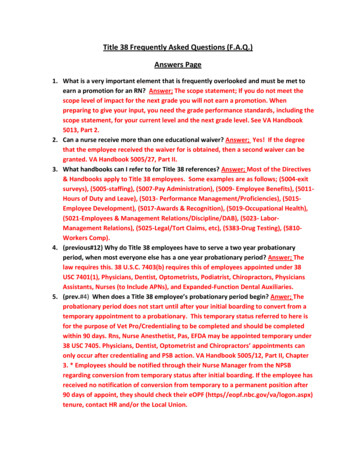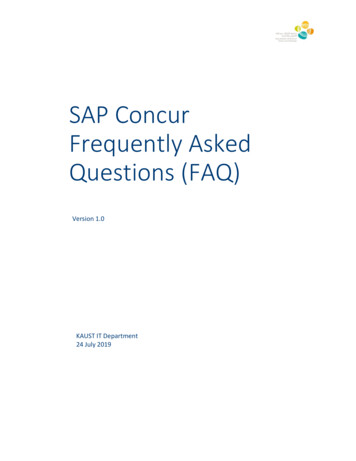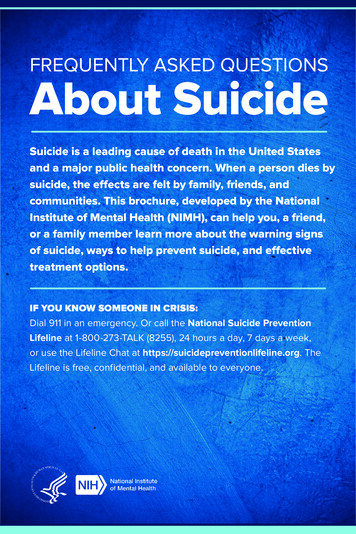
Transcription
FREQUENTLY ASKED QUESTIONSAbout SuicideSuicide is a leading cause of death in the United Statesand a major public health concern. When a person dies bysuicide, the effects are felt by family, friends, andcommunities. This brochure, developed by the NationalInstitute of Mental Health (NIMH), can help you, a friend,or a family member learn more about the warning signsof suicide, ways to help prevent suicide, and effectivetreatment options.IF YOU KNOW SOMEONE IN CRISIS:Dial 911 in an emergency. Or call the National Suicide PreventionLifeline at 1-800-273-TALK (8255), 24 hours a day, 7 days a week,or use the Lifeline Chat at https://suicidepreventionlifeline.org. TheLifeline is free, confidential, and available to everyone.
What is suicide?Suicide is when people harm themselves with the goal of ending their life, andthey die as a result.A suicide attempt is when people harm themselves with the goal of endingtheir life, but they do not die.Avoid using terms such as “committing suicide,” “successful suicide,” or “failedsuicide” when referring to suicide and suicide attempts, as these terms oftencarry negative meanings.Who is at risk for suicide?People of all genders, ages, and ethnicities can be at risk for suicide.The main risk factors for suicide are: A history of suicide attempts Depression, other mental disorders, or substance use disorder Chronic pain Family history of a mental disorder or substance use Family history of suicide Exposure to family violence, including physical or sexual abuse Presence of guns or other firearms in the home Having recently been released from prison or jail Exposure, either directly or indirectly, to others’ suicidal behavior, such asthat of family members, peers, or celebritiesMost people who have risk factors for suicide will not attempt suicide, and it isdifficult to tell who will act on suicidal thoughts. Although risk factors forsuicide are important to keep in mind, someone who is showing warning signsof suicide may be at higher risk for danger and need immediate attention.Stressful life events (such as the loss of a loved one, legal troubles, or financialdifficulties) and interpersonal stressors (such as shame, harassment, bullying,discrimination, or relationship troubles) may contribute to suicide risk,especially when they occur along with suicide risk factors.
What are the warning signs of suicide?Warning signs that someone may be at immediate risk for attemptingsuicide include: Talking about wanting to die or wanting to kill themselves Talking about feeling empty or hopeless or having no reason to live Talking about feeling trapped or feeling that there are no solutions Feeling unbearable emotional or physical pain Talking about being a burden to others Withdrawing from family and friends Giving away important possessions Saying goodbye to friends and family Putting affairs in order, such as making a will Taking great risks that could lead to death, such as driving extremely fast Talking or thinking about death oftenOther serious warning signs that someone may be at risk for attemptingsuicide include: Displaying extreme mood swings, suddenly changing from very sad to verycalm or happy Making a plan or looking for ways to kill themselves, such as searching forlethal methods online, stockpiling pills, or buying a gun Talking about feeling great guilt or shame Using alcohol or drugs more often Acting anxious or agitated Changing eating or sleeping habits Showing rage or talking about seeking revengeDoes asking someone about suicideput the idea in their head?No. Studies have shown that asking people about suicidal thoughts andbehaviors does not cause or increase such thoughts. Asking someonedirectly, “Are you thinking of killing yourself?” can be the best way toidentify someone at risk for suicide.
Do certain groups of people have higherrates of suicide?According to the Centers for Disease Control and Prevention (CDC), womenare more likely to attempt suicide than men, but men are more likely todie by suicide than women. This may be because men are more likely toattempt suicide using very lethal methods, such as firearm or suffocation(e.g., hanging), and women are more likely to attempt suicide by poisoning,including overdosing on prescribed or unprescribed prescription drugs.However, recent CDC data suggest that the leading means of suicide forwomen may be shifting toward more lethal methods.CDC data also show that suicide rates vary by race, ethnicity, age, and gender.American Indian and Alaska Native men have the highest rates of suicide,followed by non-Hispanic White males.Although the rate of suicide death among preteens and younger teens islower than that of older adolescents and adults, it has increased over time.Suicide now ranks as the second leading cause of death for youth ages10 to 14. For children under age 12, research indicates that Black childrenhave a higher rate of suicide death than White children.NOTE: After steadily increasing for many years, the overall suicide ratedecreased slightly from 2018 to 2019. You can learn more about this findingon the CDC website, at earchers are examining whether this decrease occurred across differentracial, ethnic, gender, and age groups, and whether it will continue over time.Looking for more data and statistics? For the most recent statistics on suicideand more information about suicide risk, please visit the CDC website atwww.cdc.gov/suicide and the NIMH suicide statistics page at www.nimh.nih.gov/health/statistics/suicide.Do people ‘threaten’ suicide to get attention?Suicidal thoughts or actions are a sign of extreme distress and an indicatorthat someone needs help. Talking about wanting to die by suicide is not atypical response to stress. All talk of suicide should be taken seriously andrequires immediate attention.
What treatment options and therapies are available?Effective, evidence-based interventions are available to help people who areat risk for suicide: Cognitive Behavioral Therapy (CBT): CBT is a type of psychotherapy thatcan help people learn new ways of dealing with stressful experiences.CBT helps people learn to recognize their thought patterns and consideralternative actions when thoughts of suicide arise. Dialectical Behavior Therapy (DBT): DBT is a type of psychotherapy thathas been shown to reduce suicidal behavior in adolescents. DBT also hasbeen shown to reduce the rate of suicide attempts in adults with borderlinepersonality disorder, a mental illness characterized by an ongoing patternof varying moods, self-image, and behavior that often results in impulsiveactions and problems in relationships. A therapist trained in DBT can help aperson recognize when their feelings or actions are disruptive or unhealthyand teach the person skills that can help them cope more effectively withupsetting situations. Brief Intervention Strategies: Research has shown that creating a safetyplan or crisis response plan—with specific instructions for what to do andhow to get help when having thoughts about suicide—can help reduce aperson’s risk of acting on suicidal thoughts. Staying connected and followingup with people who are at risk for suicide also has been shown to helplower the risk of future suicide attempts. Research also has shown thatincreasing safe storage of lethal means can help reduce suicide attemptsand deaths by suicide. In addition, collaborative assessment andmanagement of suicidality can help to reduce suicidal thoughts. Collaborative Care: Collaborative care is a team-based approach to mentalhealth care. A behavioral health care manager will work with the person,their primary health care provider, and mental health specialists to developa treatment plan. Collaborative care has been shown to be an effective wayto treat depression and reduce suicidal thoughts.
What should I do if I am in crisis or someone I knowis considering suicide?If you notice warning signs of suicide—especially a change in behavior ornew, concerning behavior—get help as soon as possible.Family and friends are often the first to recognize the warning signs of suicide,and they can take the first step toward helping a loved one find mental healthtreatment.If someone tells you that they are going to kill themselves, do not leave themalone. Do not promise that you will keep their suicidal thoughts a secret—tell atrusted friend, family member, or other trusted adult.Call 911 if there is immediate danger, or go to the nearest emergency room.In a crisis, you also can contact: National Suicide Prevention Lifelinehttps://suicidepreventionlifeline.orgCall 1-800-273-TALK (8255); En español 1-888-628-9454The Lifeline is a free, confidential crisis hotline that is available to everyone24 hours a day, 7 days a week. The Lifeline connects people to the nearestcrisis center that provides crisis counseling and mental health referrals. Crisis Text Linewww.crisistextline.orgText “HELLO” to 741741The Crisis Text Line is available 24 hours a day, 7 days a week. Thisconfidential service helps anyone, in any type of crisis, connecting themwith a crisis counselor who can provide support and information.What if I see suicidal messages on social media?Knowing how to get help when someone posts suicidal messages can helpsave a life. Many social media sites have a process to get help for the personposting the message. To learn more, visit -else/safety-and-support-on-social-media.If you see messages or live-streaming content that suggests someone isactively engaging in suicidal behavior, call 911 or call the National SuicidePrevention Lifeline at 1-800-273-TALK (8255).
How can I find help?If you have thoughts of suicide, tell your health care provider. Your healthcare provider will listen to your concerns and can help you figure out nextsteps. Find tips for talking with your doctor about mental health concerns atwww.nimh.nih.gov/talkingtips.To find mental health treatment services in your area, call the SubstanceAbuse and Mental Health Services Administration (SAMHSA) TreatmentReferral Helpline at 1-800-662-HELP (4357) or use the SAMHSA BehavioralHealth Treatment Services Locator at https://findtreatment.samhsa.gov.Where can I learn about NIMH research on suicide?NIMH supports promising research that is likely to have an impact on reducingsuicide in the United States. Research is helping improve our ability to identifypeople at risk for suicide and to develop and improve effective treatments. NIMHresearchers continue to study suicide and how to best implement suicideprevention and intervention programs in different settings, including health care,community, school, and the justice system.To learn more about NIMH research priorities and recent research on suicideprevention, visit the NIMH website at www.nimh.nih.gov.For additional information about suicide prevention efforts, visit the NationalAction Alliance for Suicide Prevention at https://theactionalliance.org andZero Suicide at http://zerosuicide.sprc.org.What should I know about clinical trials?Clinical trials are research studies that look at new ways to prevent, detect, ortreat diseases and conditions. Although individuals may benefit from being partof a clinical trial, participants should be aware that the primary purpose of aclinical trial is to gain new scientific knowledge so that others may be betterhelped in the future.Talk to your health care provider about clinical trials, their benefits and risks, andwhether one is right for you. For more information, visit www.nimh.nih.gov/clinicaltrials.
ReprintsThis publication is in the public domain and may be reproduced or copiedwithout permission from NIMH. Citation of NIMH as a source is appreciated.To learn more about using NIMH publications, please contact the NIMHInformation Resource Center at 1-866-615-6464, email nimhinfo@nih.gov,or refer to NIMH’s reprint guidelines at www.nimh.nih.gov/reprints.For More InformationNIMH websitewww.nimh.nih.govwww.nimh.nih.gov/espanol (en español)MedlinePlus (National Library of s.gov/spanish (en ttps://salud.nih.gov/investigacion-clinica (en español)National Institute of Mental HealthOffice of Science Policy, Planning, and Communications6001 Executive BoulevardRoom 6200, MSC 9663Bethesda, MD 20892-9663Phone: 301-443-4513 orToll-free: 1-866-615-6464TTY: 301-443-8431 orTTY Toll-free: 1-866-415-8051Fax: 301-443-4279Email: nimhinfo@nih.govWebsite: www.nimh.nih.govNational Instituteof Mental HealthU.S. DEPARTMENT OF HEALTH AND HUMAN SERVICESNational Institutes of HealthNIH Publication No. 21-MH-6389Revised 2021
Talking about feeling empty or hopeless or having no reason to live Talking about feeling trapped or feeling that there are no solutions . die by suicide than women. This may be because men are more likely to attempt suicide using very lethal methods, such as firearm or suffocation (e.g., hanging), and women are more likely to attempt suicide .
